Behind the scenes: The design work at Ralph Lauren
I don’t think consumers value design that much any more. They concentrate on price and (more justifiable) quality, but design often gets swamped by hype. What is fashionable rather than what’s well-designed.
A large part of the reason is that good design is hard to quantify. You can’t put a number on it, or make a straight comparison with a similar product. It’s aesthetics, a matter of judgment.
One way to quantify design is the amount of time, and therefore money, a brand invests in it. And the menswear brand that does that more than any other is Ralph Lauren.
Unfortunately, they don’t talk about it. Over the years, I’ve been repeatedly frustrated by the lack of product and design information Ralph Lauren supplies - to either customers or journalists. To the extent that, when I covered a hand-knit cardigan back in 2017, it took a member of the design team to anonymously comment on the article, for us to understand quite how much work went into it.
In order to try and correct this in my small way, I spoke to three ex-Ralph Lauren designers recently, to get their inside view on the product development process. They were Sean Crowley, Fred Castleberry and Peter Middleton.
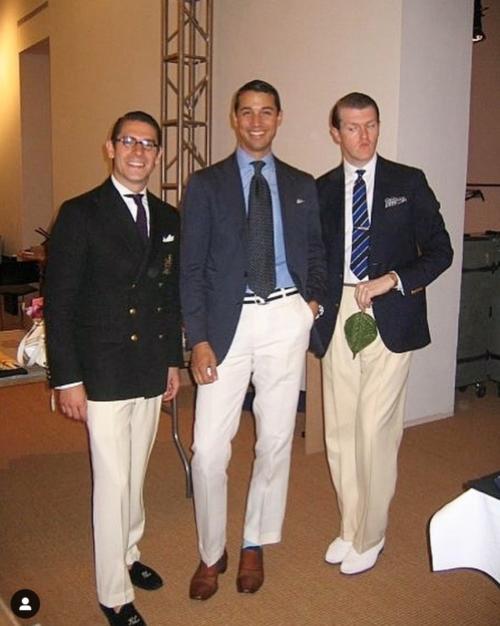
“Ralph Lauren is a design-driven company, and it might be the last one standing,” says Sean, who worked at RL for 11 years and now runs his own vintage store in New York, Crowley Vintage.
“Certainly on the evidence of the companies I worked for after Ralph, and friends that work elsewhere. Usually they have a block for their suits, shirts etc, and the decision each season is just, what colours shall we do it in? Last time it was navy, green and yellow. The navy sold best, so this year let’s try navy, brown and cream.”
These companies are often described as ‘merchant-driven’ rather than design-driven. As in, it’s the merchandising and commercial side of the business that controls the decision-making.
“At one subsequent employer I was the head of design, and every time I asked to make a tiny change - to try a different material that would add just 5c to the product cost - I was told no. Eventually I told them there was no point having a designer at all.”
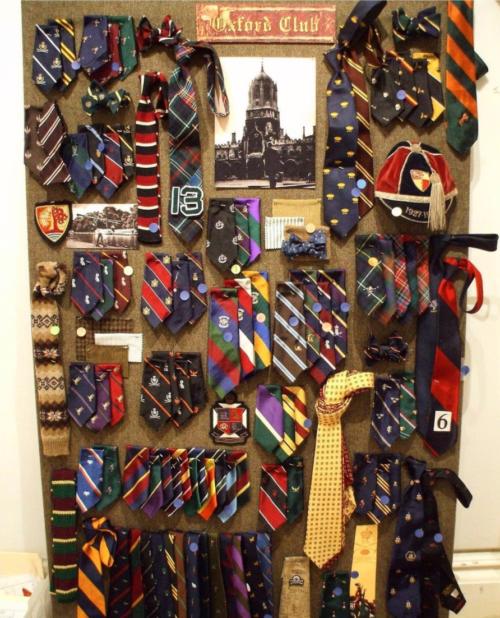
“The reason it’s easy to be design-driven at Ralph Lauren is that it all starts with concepts,” says Fred Castleberry, who ran conceptual design at Rugby, before it closed down, and now runs his own brand F.E. Castleberry.
“It sounds silly, but you actually were asking yourself every season, ‘where does the Ralph Lauren story go here?’ What’s the next room you walk into?’”
The concept was important, because it meant many of the design and product decisions were already made before the merchandising team got involved.
“I would spend weeks researching, buying vintage, drafting ideas, and then we would mock up a room for Ralph to approve,” says Fred. “He always wanted it to be set out like a store, so he could see how the customer would experience it.”
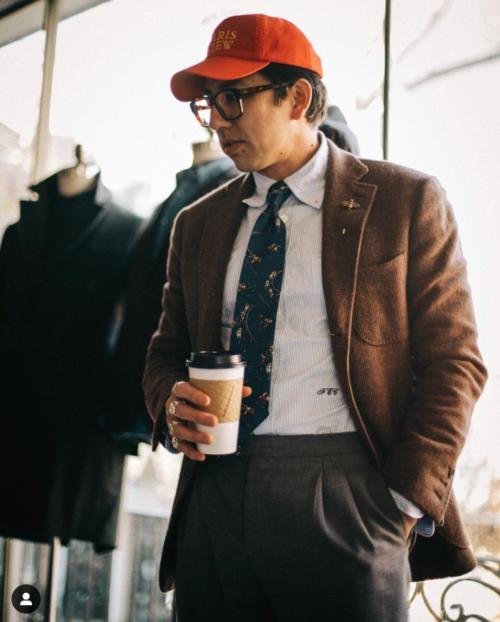
Once Ralph gave his approval, the concept team would present to all the heads of design - one for knitwear, one for tailoring, one for leather goods etc. They would spend a few weeks fleshing out the ideas, before merchandising joined in.
“There was always a tension there with merchandising, and a necessary one,” says Fred. “If it wasn’t for them, the designers would just go wild.”
But because the designs were largely in place already, the role was to control costs, or perhaps the volumes of more expensive items.
“If we had seven really complex, eye-grabbing pieces, that might be whittled down to five,” says Fred. “And maybe there would be fewer of them, used in the front of the stores rather than lots of stock. But the design concept would hang around them.”
Personally, it’s often these more unusual pieces that I buy from RL - a suede trench coat or a hand-knitted ranch cardigan - because I can feel the design work more.
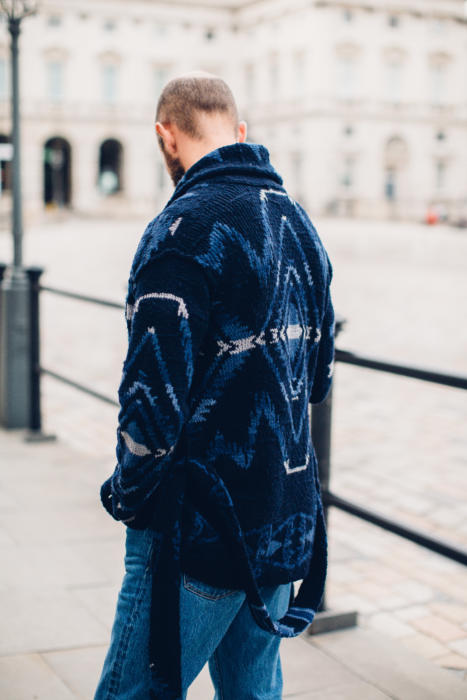
The detail on these designs would be a combination of vintage research and then innovation with the makers.
“For example, after visiting a dozen vintage dealers, we might find this old cardigan with a knit pattern that we’d never seen before,” says Fred. “We’d work it into the concept, and then when the knitwear designer became involved, we’d talk to the factory together, to see if they could reproduce it.”
The problem with old knitwear is that it tends to be both heavy and coarse. Both knitting and spinning have come on a long way.
“So the interesting thing was trying to recreate that hand feel, without the same weight or roughness,” says Fred. “For example, you might use a linen/cotton yarn, because the linen would give it the crispiness, and cotton would add a little more weight than wool. That would also produce more of a Summer knit.”
The more I work in menswear, the more I appreciate work like this that goes into materials. People like Stoffa or Anglo-Italian who develop their own, rather than just offering their customers the same books as everyone else.
And even among mills, ones like Loro Piana that innovate with their materials as well as producing tasteful designs. Unlike some merchants that are basically just holding rooms for other peoples’ cloth.
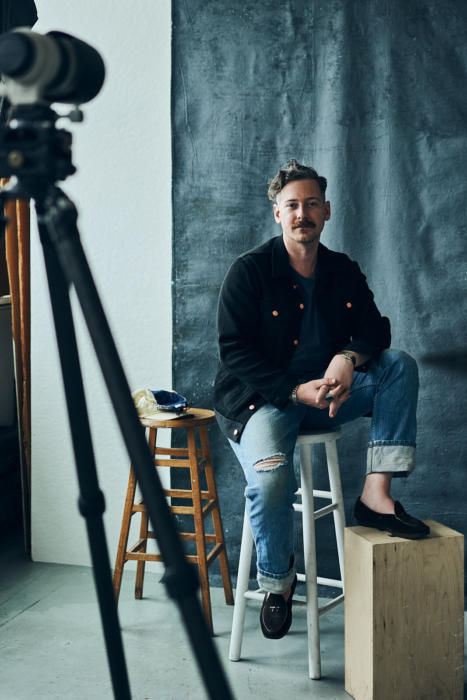
Peter Middleton worked on the textiles team for Ralph Lauren Runway - the women’s equivalent of Purple Label - before setting up his own brand, Wythe. “The amazing thing about the range at Ralph is that almost every single fabric you see in the store, no matter what sub-label, is a custom fabric.
“When we saw the mills, we’d always look through their seasonal collections, but never pick anything. Sometimes you’d even have to push back a bit, if they kept saying ‘we have this new finish, it’s been very popular’. You’d have to remind them that that’s not what we’re after. Nothing standard is going to go into the collection.”
I’ve been tempted several times to have a MTM suit from Ralph Lauren, just based on the materials. They’ve always done particularly nice open-weave Summer jacketings in brown and straw that you can’t find anywhere else.
Peter is the same. “Those Purple Label suits start around five grand, which is really expensive for a suit. You can get bespoke for less. But the kicker is the fabrics - you won’t find them elsewhere. And that’s where a lot of the value is, because so much work has gone into them.”
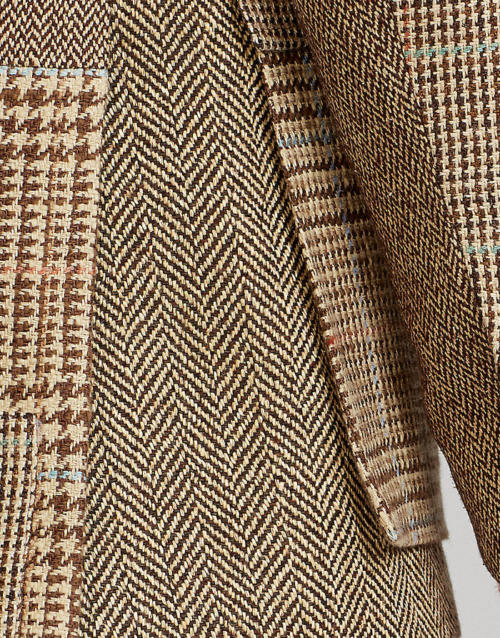
When a company is that particular about cloth and product, it has to be design-driven. It’s impossible to be the other way around.
“I remember someone once said to Ralph, ‘these other designers are doing X, which is interesting’. And he looked at them like, ‘why on earth would I care what other brands are doing?’,” says Peter.
“He just works with the same themes he loves and always has - Safari, Southwest, English countryside, blue and white - but every time there’s something new he’s excited about.
“At that big meeting of the design specialists, there might be a thousand ideas on the table, but he’ll focus on a particular leather colour. He’ll say that shade of leather is fantastic with the brown and cream here, and we’ve never done that combination’; or ‘we normally do that leather with sliver hardware, but with these knits it would look great with brass. That’s so interesting.”
Personally, I love hearing behind-the-scenes stories like this about the design process. About why I walk into a newly dressed room in the Bond Street store, and it all feels so familiar yet exciting.
“I think he’s the best at making each season different, yet the same,” says Peter. “But while others do that to try and stay current, he never is. It’s just about what he and the conceptual designers are excited about.”
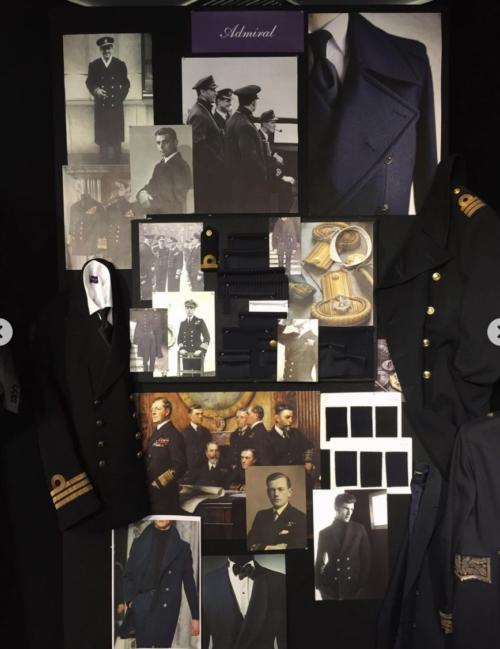
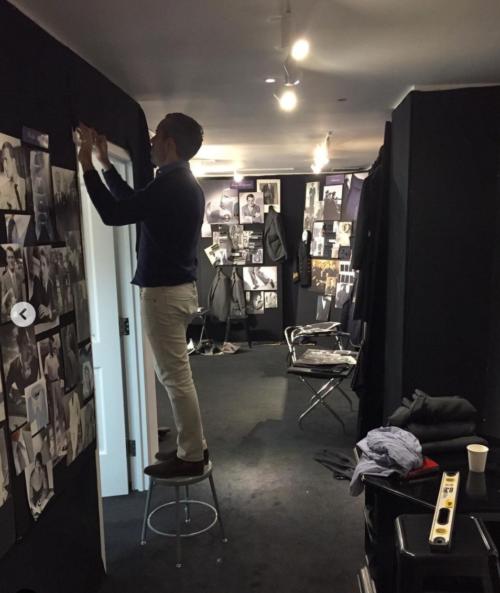
Ralph Lauren is not the only company that works this way. Many we cover do (Adret is another example).
Although, according to Peter, other companies he’s worked at function that way because the staff are ex-Ralph. He highlights Faherty, whose boss was at RRL. I’d add Antonio Ciongoli, who used to run Eidos and then founded 18 East. And of course Adam from Adret was at RL too.
None of this, of course, means that every Ralph Lauren product is unique, or good value. They spend a vast amount on shoots and advertising.
But one part of the value - design - is always there, and it’s distinctly lacking at many modern brands. Start-ups often focus on cost, delivering ‘basics’. Street brands are particularly guilty of just selling T-shirts and hoodies in lots of colours.
“I talked to friends at [X and Y] recently, and asked ‘what does a design meeting look like for you? Their response was ‘what’s a design meeting’?” says Peter. “There are ideas, but they’re just simple and delivered on the fly. Even at big designers, they’re run by young guys who throw out an idea and wait for someone to make it.”
All three - Peter, Fred and Sean - talk fondly of those big design meetings at Ralph Lauren. Where the season’s concept had spawned a hundred ideas, a thousand products, and Ralph was cutting a clean line through all of them - picking out the outfits he would wear.
“It’s very expensive, which is the biggest reason no one does it today,” says Sean. “And times are tough. I really hope they carry on doing it for a long time. You can see the results everywhere.”
Thank you so much to Sean, Fred and Peter for their help with this article. They are:


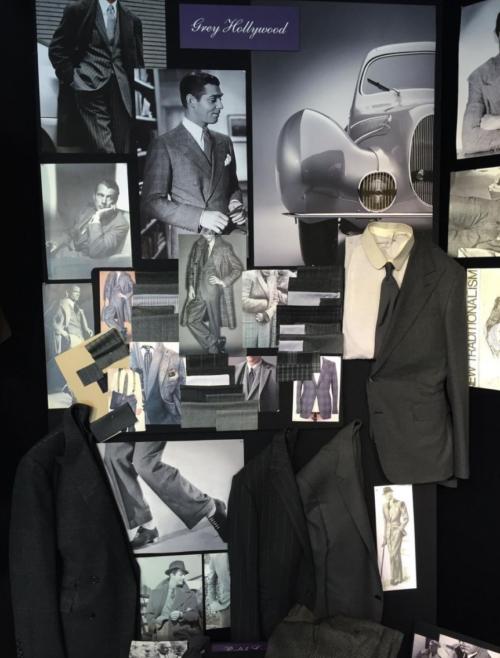
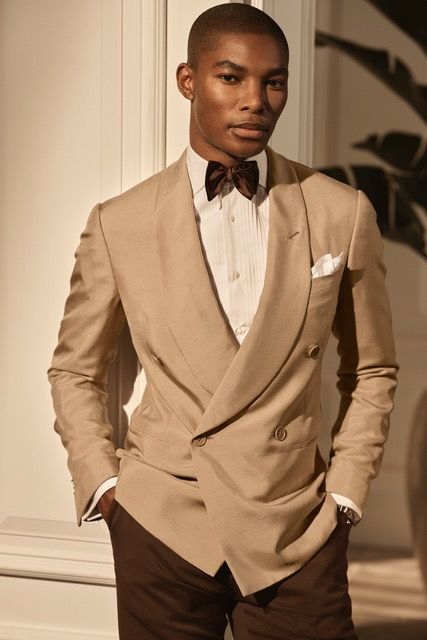


























Quite inspirational really. It is a shame RL doesn’t highlight this approach more.
Their larger stores are still a joy to walk around. Not all of the products are right or perfect, but there is always something interesting.
I just hope they can keep it all going through this very choppy retail climate.
Really interesting, thanks Simon.
Wonderful article, thank you Simon, great isnight.
I struggle immensely with the proposition offered by Ralph Lauren. Specifically, they seemingly put all this effort into product design, but the quality of the make is terrible. I bought a brown herringbone sports jacket from them a few years ago (a similar fabric to the one shown above) and the stitching along some of the seams was literally hanging by a thread when it arrived in the post. The fabric was exceptionally thin and the whole jacket felt cheap. I place much more value on quality of make than design, especially as many of the staple pieces in a sartorial wardrobe are simple and understated, and therefore not design-led.
Yes unfortunately the quality varies immensely. And I completely agree on more staple pieces
A really intriguing and insightful read, thanks Simon. Something of a PS deep dive, a PS ‘Long Read’.
You’re spot on that the lack of fanfare about their design-led approach undermines their appeal for unwitting potential customers – myself among them – especially when the Polo line is the thing that they are probably most known for. On reflection, even Polo seems to benefit from Ralph’s design ethos, but to a casual observer it smacks of the basic monogram merch approach as offered in countless identikit designer diffusion lines.
Also a shout out to Mr Castleberry; his style and brand images often feature in the inspiration shots on A Little Bit of Rest, and I’m always impressed.
I’ve had a long association with RL since my youth, and always look forward to a new season.Sadly, much of their modern performance is akin to a British sports car, magnificent lines let down by awful quality control. RRL is still a go-to brand for me(or at least to look at), being especially fond of their knitwear.
With such much of our basic style coming from quite narrow origins, design(and this is a fascinating read Simon) will always take second place to performance.
Just for balance, RL is probably the largest single design in my wardrobe.
In an age where every brand puts forward a half-baked origin story that’s supposed to be driving their “mission” (like some kind of Silicon Valley incubator), Ralph reminds us what real story telling is all about.
One of the most interesting articles yet.
Brilliant piece. I would hugely welcome a review of their MTM, for what it’s worth Simon. I’d also love a robust look at RL’s quality – there’s a general feeling that it’s slipped over the years, but it would be really interesting to learn exactly how a Blue label jacket now compares to one from the 80s, or how Purple Label compares to other top end RTW. (I appreciate this kind of piece is not expressly the remit of PS, but given your personal interest in the brand, and its special status as a classic menswear bedrock over so many years, I feel it would be justified). Btw – possibly ‘X and Y’ was a placeholder you intended to fill in?
Thanks Peter, and good suggestions.
You get a decent idea of the quality of the MTM – though not of course the design or the cloths – if you look at the MTM I had with the Armoury last year.
On the X and Y, no that was meant to be me blanking out the company names, though obviously I didn’t do that very clearly.
I’ve been wearing Ralph Lauren polo since I was given an oxford shirt for my birthday , it is by far the brand I have bought the most in the past almost 30 years but the quality for the cost can be shocking ( £129.99 for a sweatshirt with 40% polyester ? ) purple label is fantastic but if I could afford £1000 for a cashmere jumper I would go to loro piana or buy 3 jumpers from lockie ) it’s a shame as I love the design but if I bought from the actually produces of purple label direct it would be maybe a quarter of the price
Dear Simon,
Thank you for highlighting the design aspect of clothing as an integral part of the cost of a product.
Many of us will be considering buying Bespoke or MTO clothing based on the suggestions and reasons you have given so many times.
We would assume that a good tailor will take care of the fit. Such as we assume a good plumber will ensure there are no leaks.
Let’s also assume that the quality of the products he fits will be appropriate for the use intended. Although with tailoring this is still given as a choice to the purchaser as though he/she is qualified to make the correct decisions.
However, the plumber does not design the bathroom, which is ultimately what you are after.
So, we the potential purchaser is left with all the design options. I think for many of us, we recognise this a stumbling block to making a good purchase.
It is good to know that Ralph Lauren spends so much time on design and this is ultimately what has differentiated the Brand. The styles are always retrospective. The value seems to be in subtlety of blending materials, which can be easily underestimated and therefore a potential pitfall when investing in a bespoke suit.
You have made so many blogs etc. on style choices, and some on guidance for first suits, cautionary tales etc.
Have you or would you make a suggestion specifically about design choices.
In essence tailors, can guide but will effectively do whatever you want, however ill-advised.
So, is there a service or person that advises you for you and not general principles or tainted by own self-interest as such a trusted adviser.
Choosing a tailor or house style, means you have already made certain choices that may not be appropriate.
A bespoke suit being upwards £3,000, getting the design right obviously has considerable value, and trying to do it yourself as a rank amateur, is obviously fraught with mistakes.
There is a value to this and I am not sure what that monetary cost is.
Is this something you do or can you make suggestions.
Once again thank you for a thought provoking article.
Neil
Thank you Neil.
It’s certainly a service I can provide, and have done in the past for readers going to a tailor for the first time. Either in person or digitally.
As to advice on who best to do this without me there, I think the most important things are to pick a tailor whose house style fits what you want – basically, you have seen what they make, tried it on, and like it. That makes such a difference.
And then the other thing is you have read something like the Suit Style Guide on PS, just so feel confident in all the little choices you will be asked to make and the tailor wouldn’t do for you.
I completely agree with you that these design points are fundamental, and it’s a huge risk not doing them well given how much you’re spending
I’m always a dissenting voice in discussions of Ralph Lauren. The brand and the story don’t do much for me. In terms of design, I think RL is a brilliant merchandiser and marketer. The designs are simply derivatives of, as said in the article, Safari, Southwest, British countryside, and one or two other sources. Season after season, decade after decade. When I’ve tried RL, I’ve always been disappointed by the fit and finish. And, as with Tom Ford, I can see no reason to pay RL prices for a suit, say, when I can have the exact same thing made for me for much less. And, honestly, a unique cloth isn’t a good enough reason.
Thank you Andy.
Personally, I think the case is stronger for things other than a suit, as you say, but I still think design is often underrated. Speak to someone that designs tailoring, for example, and they will often eulogise the shape of the Ralph Lauren shawl-collar on a jacket – several people in the industry have said that independently to me, as soon as they pointed it out, I saw it and it became the yardstick for how I judge other shawls.
This doesn’t mean the design is always the best, by any means, but given design is – I personally think – the area bespoke tailors most obviously and frequently lack, I think it should be part of the consideration.
I think the point about designs being derivatives deserves a longer conversation. Everyone takes inspiration from others – whether RL designers or Navajo weavers.
Hi Simon,
Great article and gave me food for thought. RL doesn’t do it for me – never did. However, I can appreciate the design. Like others have mentioned, the quality of the fabrics is questionable. I prefer RRL and bought a chambray shirt and wore it a lot. I wish they wouldn’t wash a lot of their fabrics to give it a worn patina, and would rather do that myself.
There are other companies such as J. Press who offer the preppy/Ivy style and do it better in my view.
Regards,
Andrew
I wouldn’t disagree with you on any of your points in this reply, Simon. You may be right about design for items other than jackets or suits. I’m not sure that RL is on one side of a design gulf with all bespoke tailors on the other. Edward Sexton, for example, is one tailor that I think has a good design sensibility and Cifonelli is another.
And, sure, we all take inspiration from existing design languages, but that does not dilute my point about RL being derivative. RL did not invent the stylistic areas in which he works. He adapted them for a mass market and marketed them as entry ways to a lifestyle he promotes. And there’s nothing at all wrong with that–RL does it better than most.
Thanks Andrew, I think we’re on the same page with most things.
There are certainly tailors, like Edward, who have a great sense of style. They are rarities, however, and often their style is both quite an extreme one, and was established at one point in time and hasn’t changed since.
My point with RL design is that it’s easy to think the team have just taken and marketed, but actually there’s a huge amount of design work involved that often evolves designs, adapts them, and creates unique versions. You only need to talk to people in the design team – as in this article – to realise how much of that there is. The result is that most of the time the RL versions of those design traditions are nicer (for me) than the originals.
Most insightful article, Simon. Although I agree that Ralph Lauren is derivative, I also believe that he is a genius. I suppose the simplistic argument is that he basically took Brooks Brothers, spiffed it up and delivered it to the masses (although it was not originally targeted to the middle market). However, it was clear the moment you walked into a store that something special was going on. I have not done so in some time, but I believe there were and are certain flagship stores that deliver the full Ralph presentation such as the Rhinelander mansion in New York.
That uniqueness clearly stemmed from the design work (which was promoted by stunning print advertising, particularly in the 80s) that you have so wonderfully described in this post. That’s why it worked. The “world of Ralph Lauren”, a tagline that still may be used, was aspirational for many, yet accessible with an item as basic as a polo shirt with an equestrian logo.
In the late 1960s or early 70s when I was in boarding school, my father, a devoted Brooks Brothers’ client, walked into Wilkes Bashford (whom I believe was the first retailer to market RL on the West Coast) and purchased a solid navy blue, silk twill tie (a wide one) for a Christmas gift. Only I knew what it was, but I felt as if I were the “coolest kid in school” when I wore it to Sunday dinner with a Brooks Brothers grey flannel suit and white Oxford button down shirt. To be clear, I was not making a fashion statement per se and was never “the coolest kid in school,” but we had a dress code for dinner (prehistoric, but true). And I still have the tie.
Interesting article.
Although there is something intoxicating about RL’s imagery, I haven’t bought anything for years.
It’s long been a triumph of style over substance.
Personally I much prefer shopping at A&S , Anglo-Italian or PWVC. The quality and service is at a different level.
That said RL did do a bang up job redesigning the interiors for Jamaica’s ‘Roundhill ‘.
You say RL is one of the most design-led menswear brand of all. is that right though? i mean all the major designer brands, tom ford, gucci, margiela etc are far more design led aren’t they? admittedly not value for money…or to the PS taste. Or am i missing something here? Thanks
Yes Zo – the point is that a lot of those brands seem design-led, but actually they are driven very much by commercial imperatives. Less so the smaller and more independent designers, but it’s the case with a lot of the big brands.
Separately yes, you’re right, RL is much more significant for PS readers because the clothes are more classic, everyday menswear.
thanks, i understand.
if you had not highlighted the above story, i honestly would never have guessed ralph lauren had a huge design team. i associate them with cricket jumpers, madras, dogtooth jackets, rep ties and the ubiquitous polo. even in their shops season after i find the same colours, the same styling, the same proportions, same fabrics. i mean, theyre not a bad shop, i would happily purchase an item here and there, but definitely wouldnt have guessed theyre design-led.
Hi Simon
I’ve so far had one suit made by RL double breasted just the regular polo range and I have to say it stands up well.
I’m currently having a purple label made double breasted pinstripe and so far it looks amazing. The rep who is doing my suit showed me all possibilities when it comes to finishing the suit (something you get way more possibilities when paying for purple label). I’m not sure if it’s worth the price point I think mine is at just under £5000 but I’ve always been a sucker for shelling out unnecessary money / necessary money whichever angle you’re looking at it from.
Interesting, thanks.
I guess part of my point is that you’re not necessarily a sucker – you’re just paying for something different.
I’ve been to the Flagship Ralph Lauren here in NYC several times and have never been impressed with clothing nor with the surroundings. Never bought anything nor have any desire.
This is a great article, thank you for highlighting more about the design process.
I am a designer for a premium fashion brand and have been lucky to work with many gifted designers. I do believe this is part of what you are paying for when you buy from certain brands; it is a highly competitive industry where the designers have had to train either in house or with a degree, most likely intern for no pay for well over a year (working crazy hours) and then work up through the roles over the years. So much passion goes into the research, design and development of each season.
it is great that you are speaking about this more as it does show that you are paying for creativity and talent when you buy from certain companies, and although it is often the case that you get better value for money in terms of quality in bespoke, there is a value in design.
George.
From experience, would you say that fabric and colour choice are the only areas where there is blank canvas, or is there more creativity then the average consumer gives the industry credit for?What is the spark for a new season?
Thanks
Depending on the company you work for, creative freedom can be quite broad. For menswear to be commercial, there are generally limitations on silhouettes but much can be explored within those. In general, a season would start with a concept like Simon mentions above, where you research into mood imagery, garment, brand heritage if applicable and then also into fabrics, trims and finishes. There is always structure to a collection and commercial needs have to be met, but there is often space for the design led pieces which are inspired by the research and functionality. The seasonal concept comes from the design team and their taste and interests.
It is all of this that is combined which can then create new and interesting design where all details are considered and chosen to best reflect the seasonal concept. For example, it could be a bomber jacket silhouette that takes some details from heritage flight jackets and combines it with modern trim details and fabric functionality.
There will always be the high margin, high unit branded items which make the money for the brands, but there are often these hero pieces within a range which resemble much of the research and development that inspires the whole season.
A very brief explanation but hopefully gives a little insight!
Thank you so much. That is very interesting. I find this type of discussion stimulating.
Always the most important thing….
typo in the 3rd paragraph below the photo of Peter Middleton. I was like wtf is pen-weave? considering the mentioning of exclusive fabrics the RL team make. I loved this article. thanks
Thanks! Should have said ‘open’
Andrew “I wondered what ‘pen-weave’ meant”?
Great article Simon. Would love to read more like this one. Thank you!
I bought my first Polo sweater when I was in college several decades ago. And I haven’t bought much of the brand since for one simple reason – the quality of the clothes do not justify the price. Ralph Lauren began his career as a designer with a vision and is now (or at least the company) has evolved into a brilliant marketer to the masses. And in the USA, he has better than most, tapped into the American psyche of a logo is proof of status. And cost, nor lack of quality, is ever an issue when that is for sale in the American marketplace.
A friend who used to be a fund manager at the investment arm of a major high street bank said he looked over Ralph Lauren’s books and found 80% of their stock is shipped directly to discount and outlet stores (although perhaps he meant specifically Polo) so the listed retail price is not the true market value of the garment (if we assume that’s the average price a customer pays)
He said it’s a similar situation with most big designer labels but if you know your stuff you can find the good pieces that justify the price tag.
Hey Tommy,
It’s well known that RL makes a lot of its money from discount stores – but it is really just Polo, and some of that product is made specifically for the discount stores too, so it isn’t necessarily the same as the product you see in the stores.
S
Yes, a common occurrence these days: brands making items directly for discount stores rather than just shipping out surplus. Though presumably the items have to be offered at the higher notice in a limited number of outlets to justify the supposed discount?
You might be right, I don’t know what the law is. You have to in the UK, though only for a few weeks I think, but don’t know about the US
“so it isn’t necessarily the same as the product you see in the stores.”… for average person, difference is neglible, for polos at least… I’ve been wearing RL discount polos for about a decade. last year I wanted one particular colour so bought full price from John Lewis… and I can’t tell the difference from the ones Ive been buying for 40£ from tx maxx for last decade. p.s. But to be honest last couple of years I’ve been getting more disappointed with tx maxx RL stuff.. quality seems to have gone massively down…
I guess with any large brand that’s selling at that sort of scale and competing on price point, there must be enormous pressure to cut corners in order to increase margins.
I tend to treat TK Maxx like a jumble sale: the fun is in finding the gems hidden among the dross!
Simon-
I occasionally stumble upon references to early careers at RL and the opportunity afforded by RL the man. Usually with fondness and gratitude. There seems no denying that as a design incubator the culture seems positive, maybe as a result of the tone set by the man at the top? Simon do you have any insight on this?
I’m afraid not Robert, company spirit and internal management weren’t things we really talked about. Except to agree with what you said, that there is a strong alumni
Off topic of this post…………………I know you’re not hot on gaberdine trousers from your past comments, however I require a little help. I wish to commission a pair of cream/ecru gab trousers without a lining therefor not a transparent material/weight. Any recommendations I can give my tailor as to a fabric merchant, batch number, perhaps some info re the pair you had made some years back?
Have a wonderful pair of 9oz coffee Holland and Sherry Gabs just finished. The 9oz H&S cream gabs material are see through therefor not suitable for non lined trousers.
Have ecru Fox cav twill, cream Brisbane Moss cords, this would fill the gap.
Help!
Hey Guy,
I assume we’re talking about wool gabardine here, not cotton?
The nicest ones I’ve had have been from Holland & Sherry – Dakota bunch – or from Drapers. I haven’t really looked at cream though, so couldn’t tell you which were good unlined. I’d also have mine lined anyway, just because I prefer the feeling and ease of movement.
S
Excellent article, pleasure to read.
Now into my seventies I’ve worked with many menswear companies internationally, late 1960s onwards.
In New York I found that Paul Stuart had a refined subtle sensibility much to my liking. Excellent quality. Rather less obvious than RL, (1970s- 80s)…
As a general comment, if at Senior Board level there was no design-led Director who understood and would fight for creativity, the product would be banal. This may seem obvious but …
Ben Frankel.
An interesting discussion! As an aged ‘lo head lol who has amassed a decent collection of Polo items made anywhere from 1969 through the present, the quality really runs the gamut even in the early years and that is before you start looking at the things made directly for outlets more recently. From a suiting standpoint, I will say that I have taken all types of suits and jackets across all eras to a bespoke Italian tailor near my home and he has sometimes admired the suits and sometimes laughed out loud at what he deemed to be poor quality. We were both impressed with an early 1970s three piece suit, singlebreasted with wide peaked lapels, that was made either by Norman Hilton or the Lanham facility in Mass. Very nice flannel in that ‘70s does ‘30s style that RL was doing around The Great Gatsby. I would hold some of these ‘70s suits up to later Purple Label as they also appear to be fully canvassed with nice little details like some pick stitching or real horn buttons. The 1980s suits also have lovely fabrics with nice stylings but with some oddities that perhaps indicate a very slight decline in quality – the tailor guffawed when he saw that the suspender buttons were not sewn firmly into the lining of one pair of pants (they were just sewn into a skirt piece around the waist that sort of flew up when we tried the suspenders). I’ve also found wonderful pieces with things like pocket flaps on the suit jacket that were uneven or even patterns that didn’t match on the lapels of a glen check tweed suit. I don’t know if these sorts of things can be chalked up to a lack of quality control from when the company was much smaller. However, while the American-made stuff runs a smaller gamut with little idiosyncrasies like that, I find the later made Italian stuff for the Polo and Purple Labels to be of a fairly standard high quality. Just my two cents from a convicted RL admirer. . .
Thanks Dan, really interesting. Always appreciate customer experiences dating back before I was born!
I myself was born in ‘76 so a good deal of these items pre-date me as well! But I’ve been fortunate enough to find some vintage PRL pieces that harken back to the earlier days. And there is a certain timelessness to the Polo aesthetic . . .
Aha, well that makes me feel a bit better.
And good point on the aesthetic. Sticking to your design guns for so long certainly has the benefit that most of your old clothing remains relevant
no wonder RL has the cohesiveness in its season that others sometimes just lacking a bit
Thank you for this article. RRL is one of my favorite brands. Is there any other brand that produce a better shawl collar cardigan? I always intuited some kind of design process being the difference, but its nice to actually read about it.
I’m not sure about better, but there are plenty of plain ones that are just as nice, just different cuts. Including Drake’s, Anderson & Sheppard, Begg and Permanent Style
Loved reading this! Thank you.
Interesting article on Fred Castleberry here:
https://nypost.com/2022/12/09/nyc-luxury-designer-fred-castleberry-jailed-over-child-support/
Wow… what a scumbag. Interesting in the article he owed money to owner (now deceased) of Manolo Blahnik – the same guy who was evicting Andre Leon Talley from his white plains home. I guess he helped him start up his brand.
This article should give anyone who doesn’t understand why Ralph LAUREN is the best American designer then nothing else will. Ralph understood from the very begining that good designe must come first.
Thanks Steven, nicely put
Well done…